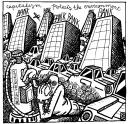The other day, a reader wrote me about a piece I’d written entitled, Why New Zealand? He thought that I was a bit over the top with my praises of New Zealand as a destination.
Indeed, he had some good cautionary points about New Zealand as follows:
New Zealand owns a heap of public, external debt; all summed, this debt aggregates to 41% of the national GDP. I do not like reflecting on that percentage. Let’s reflect, anyway. National revenue now exceeds national expenditures, by $100 million. National expenditures budgets for payment of debt interest but not debt repayment. $100 million in public profits for a nation of 4 million: not sound.
New Zealand has a population growth rate of 1.12%. America, by due compare, only has a population growth rate of 0.89%. Which of these is healthy, and which of these is not? (Neither is healthy – of course. But one is in better accord with reality and one is not.)
New Zealand currently suffers from deforestation, soil erosion, top-soil depletion, and catabolic agricultural collapse. So does America. To quote a recently published academic paper which I tripped across, “A significant consequence of agricultural development has been the loss of native vegetation, including forests, wetlands and tussock grasslands, and biodiversity. Farming in New Zealand ranges from intensive to extensive practices. Intensive farming has higher concentrations of animal waste, fertilisers and pesticides and is implicated in the contamination of soil, groundwater and streams. Extensive farming of hill country has resulted in mass erosion, due to the loss of vegetation, resulting in the loss of topsoil and increased sedimentation of waterways. Agricultural development has been driven largely by economics, fluctuating with export prices and past government subsidies. There is currently increasing pressure for farmers to intensify due in particular to the global market for dairy products and niche market products, and improved technology.” Sound familiar? It sure does.
New Zealand is predominantly mountainous. Current estimates of arable land have you at only 6% of your land-mass. Current estimates of arable land in America, on the other hand, extend from 18% to 28% – and I am more inclined to believe 28%, given the still-tremendous fertility of California, the Great Plains, and the Empty Quarter. How will you feed 4 million, on only 16 thousand square kilometers of arable land? The isolation, which you value, also isolates your people from the protective value of emigration: if events on either island “go south,” you won’t have a South to emigrate to.
80% of the population lives in cities. That may be a good thing, for those sequestering themselves into the hills. I’m more inclined, however, to believe that city dependency breeds abstraction and alienation from the land, and ignorance of base necessities. It won’t be good, when ignorant city-hordes unravel across your terrain.
These all seem like good points – though I can’t comment on them as being true or false without doing some research.
I’ve spent a fair amount of time now in New Zealand and I’d still hold, even in the face of these negative points all being true, that New Zealand is arguably the best place in the world to run away to if you fear the coming Perfect Storm.
If you doubt this assertion, just lay a map of the world out and begin to go over every place you can think of that might provide a safe haven in a world of chaos. And for each place you consider, look at the points I’ve made in favor of New Zealand and the ones my correspondent has asserted against it.
I have other correspondents in New Zealand who wish I’d just shut up on this subject <smile>.
They like that New Zealand is one of the world’s best kept secrets. And they don’t want to see paradise over run with refugees from the rest of the world’s insanities. And the truth is that for the most part, I agree with them. Fortunately, this Blog has a fairly small readership and immigration to New Zealand isn’t a subject I’m going to spend much time on from here on out.
If I can help alert people to the coming Perfect Storm, then that’s enough. Each of you will have to work out what you want to do about it on your own. I’d just caution you not to wait to bolt until the signs are unmistakable.
One final note. My correspondent is immigrating to New Zealand from the US. Apparently, the negative points he’s cited, while worrisome, are not sufficient to dissuade him from recognizing a good thing <smile>.
Cheers!
– thx to Brian C. for his input on this piece


 ??
?? 




